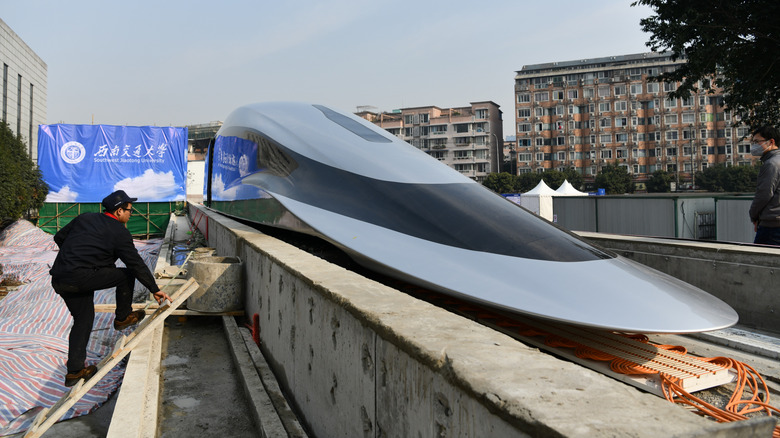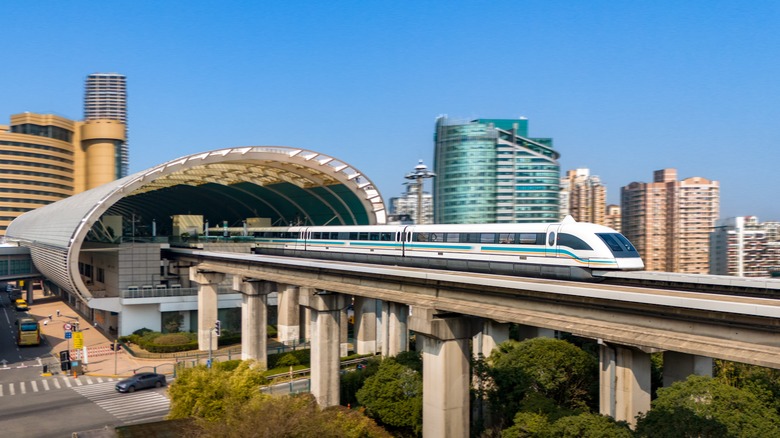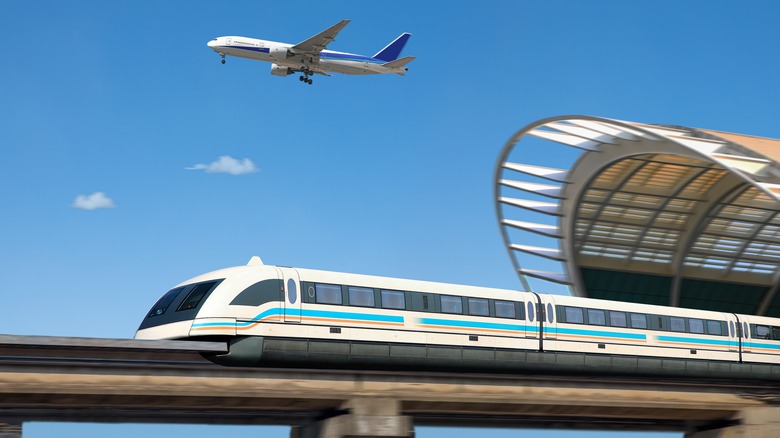
While it's not yet operational, China has been testing a magnetic levitation (maglev) train, the CR450 and successfully clocked speeds exceeding 620 miles per hour. For a bit of context, your average commercial passenger jet cruises between 480 and 575 miles per hour. And it's not just how fast this train can go, but also how quickly it can accelerate. Most recently, China's magnetic marvel shot up to over 400 mph in less than seven seconds.
The train is able to travel so quickly because of an almost
complete absence of friction. The train hovers above the ground and uses incredibly powerful opposing electromagnets to propel it along the track, leaving aerodynamic drag as its chief concern. However, photos of the CR450AF bullet train from 2024 showcase a dramatic tapering nose on the front car, indicating the development team's efforts at minimizing air resistance as a significant factor. When officially launched, this maglev will surpass the fastest high-speed trains in operation today, including China's own Shanghai maglev.
Read more: 5 Of The Best Travel Trailer Brands (And 5 To Avoid)
What Are The Challenges Of Developing A Significant Maglev Network?

Expanding and advancing maglev train travel is quite the undertaking, especially considering all the work that went into China's groundbreaking Fuxing Hao trains. Being the fourth largest country on Earth, not only is there significant ground to cover between different regions, but the cost of construction and regular maintenance is eye-watering. Some studies have shown that building a maglev network and the money required to operate it day-to-day are up to five times greater than traditional high-speed options.
Costs compound when you also consider that maglev tracks can't be utilized by any other types of trains, and existing tracks can't conversely be co-opted for use with the CR450. An often-neglected aspect of these maglev trains is something called aerodynamic noise. While the train is essentially floating on electromagnetic fields, it can still produce harmful levels of sound at high speeds.
For instance, when the Shanghai maglev passes 430 kilometers per hour (267 mph), sound pressure from 35 meters away from the track can register at 96 decibels (the equivalent noise level of power tools). So, in addition to tracks and stations, maglev train networks require sound barriers and special tunnels to help reduce the noise.
The Advantages Of A Train That Goes Faster Than Commercial Aircraft

Obviously, the CR450, with its incredible speed, could get commuters to their destination quicker, but the benefits go well beyond that when you consider how this maglev could transform China. For instance, people could live in one region of the country and work in another, where previously the distance and even speed of the fastest passenger trains would have been too great a barrier. No one would realistically commute to work every day if it required taking multiple flights.
However, since the CR450's speed surpasses that of most commercial jetliners, it could whisk working professionals back and forth across the country over hundreds of miles with ease. This enhanced mobility would also open up areas of China outside of its massive urban cities. Communities, housing, and businesses could spring up along the maglev's network of tracks, with no need to be centralized or located in the heart of big metropolitan areas.
This, in turn, could significantly reduce aspects of daily life, such as traffic congestion, which can be so severe that it has created headlines. Take, for instance, the legendary situation on China's Highway C110 back in 2010, where a traffic jam went on for 12 days.
Want the latest in tech and auto trends? Subscribe to our free newsletter for the latest headlines, expert guides, and how-to tips, one email at a time.
Read the original article on SlashGear.











